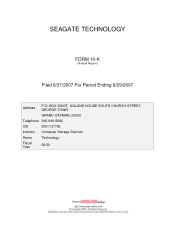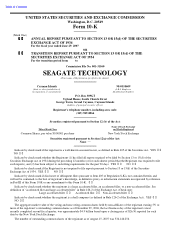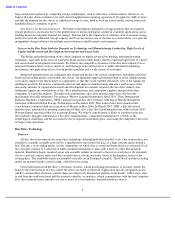Seagate 2006 Annual Report Download - page 7
Download and view the complete annual report
Please find page 7 of the 2006 Seagate annual report below. You can navigate through the pages in the report by either clicking on the pages listed below, or by using the keyword search tool below to find specific information within the annual report.
Table of Contents
Industry
Electronic Data Storage Industry
The electronic data storage industry is comprised of companies that participate across the entire electronic data
storage value chain and information life cycle, either by providing hardware storage solutions, components for
hardware storage solutions, value added storage solutions, software or services.
Participants in the electronic data storage industry include:
Major subcomponent manufacturers. Companies that manufacture components or subcomponents used in
electronic data storage devices or solutions include companies such as Komag, Inc. (“Komag”), which is in the
process of being acquired by Western Digital Corporation (“Western Digital”), TDK Corporation (“TDK”), Fuji
Electric Device Technology Co., Ltd. (“Fuji”), Showa Denko K.K. (“Showa”), and until the announced acquisition
by TDK, Alps Electric Co. Ltd. (“Alps”), that supply heads and media to disc drive manufacturers as well as
semiconductor companies such as Samsung Electronics Co. Ltd (“Samsung”), SanDisk Corporation (“SanDisk”),
Micron Technology, Inc. (“Micron”), and Intel Corporation (“Intel”) who manufacture flash memory.
Hardware storage solutions manufacturers. Hardware storage solutions are also provided by a variety of
technologies such as disc drives, tape storage, as well as semiconductor-based storage technologies such as flash
memory. Companies that make hardware storage solutions include disc drive manufacturers such as Seagate
Technology, Western Digital, Samsung, Fujitsu Limited (“Fujitsu”), Hitachi Global Storage Technologies
(“Hitachi”) and Toshiba Corporation (“Toshiba”), magnetic tape storage manufacturers such as Quantum
Corporation (“Quantum”),
as well as semiconductor companies such as Samsung, SanDisk, Micron, and Intel, whose
products include flash memory.
System integrators. Companies that bundle and package storage components such as hardware storage
solutions and software into systems for compute, consumer electronics and enterprise applications, include personal
compute OEMs such as HP, Dell, Inc. (“Dell”), Acer Inc., Lenovo Group Limited, and Apple, Inc. (“Apple”);
consumer electronics OEMs such as Apple, Sony Corporation (“Sony”), Microsoft Corporation (“Microsoft”),
Motorola, Inc. (“Motorola”), Directv Group, Inc., Tivo Inc. and Scientific-Atlanta Inc., a Cisco System Inc.
company; enterprise storage system OEMs such as, HP, EMC Corporation (“EMC”) and Network Appliance, Inc.
(“Net App”).
Storage services and software providers. Companies that provide services for the backup, archiving, recovery
and discovery of electronic data, or the software to enable businesses and consumers to do so, such as Symantec
Corporation (“Symantec”) and EMC.
Demand for Electronic Data Storage
We believe that the amount of data stored and accessed electronically is growing rapidly. We believe the key
factor driving this demand is the mass proliferation of digital content. While the electronic data storage industry has
traditionally been focused on compute applications for the enterprise and corporate markets, a continued proliferation
of non-compute applications in the consumer electronics market is increasingly driving the broad, global expansion
of the demand for electronic data storage driven by:
We believe that because digital content is increasingly rich in media with the mass utilization of photos, video,
movies and music, the related storage applications and solutions increasingly require higher storage capacity to store,
manage, distribute, utilize and back up richer media digital content. This in turn has resulted in the rapid growth in
demand for electronic data storage hardware solutions that either directly utilize disc drives, or indirectly drive the
demand for additional disc drive storage to store, host or back up related electronic data content.
4
• the creation of all types of digital content such as digital photos, video, movies and music by consumers, as
well as devices for enjoyment, consumption and preservation of such content such as DVRs, digital music
players, handheld applications, gaming consoles and storage devices in automobiles;
• the aggregation and distribution of digital content through services and other offerings by companies such as
YouTube by Google Inc. (“Google”), Flickr by Yahoo! Inc. (“Yahoo”), iTunes by Apple and MySpace by
News Corporation (
“
News Corp.
”
).




















